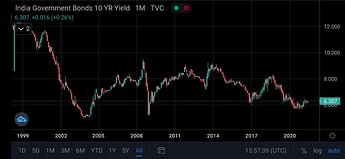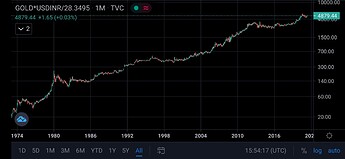So it’s technically a “fiat gold” right? Backed by a promise and nothing else.
Yes, The underlying asset is the Govt. promise to pay you the current price of Gold. Sovereign guarantee.
Some investors have a little issue with SGB that Gold is seen to diversify and hedge risks because you have a contrarian view with the Govt and economic policies. And in adverse cases, you can back on the gold because it is an international currency. But going the SGB route is like you take fire insurance for your house from the same company that can cause a fire in the first place. According to that set of investors, this is defying the ideal principles of diversifying.
Every asset class has pluses and minuses. Just that one should be aware of what he is getting into.
I recently read an article from Arthapedia (Wikipedia-like website maintained by Indian Economic Service) about their plan to manage risk associated with SGB. It says:
Gold Reserve Fund is a fund created by the Government of India to take care of the risk associated with its two schemes – Gold Monetization Scheme (GMS) and Sovereign Gold Bonds Scheme (SGB)– due to an increase in gold price.
Gold Reserve fund is created by depositing the notional savings enjoyed by the Government in the costs of borrowing from GMS and SGB, as compared with the existing rate on government borrowings.
This doesn’t look sustainable, especially considering a situation of falling interest rates(less inflow into the fund) and rising inflation (more outflow from the fund).
And they don’t seem to have a well defined plan if the above solution didn’t work out well. ![]()
The Gold Reserve Fund will be continuously monitored for sustainability. As per the present provisions, the gold deposit will not be hedged and all risks associated with gold price and currency will be borne by the Government of India through the Gold Reserve Fund. The position may be reviewed in case ‘Gold Reserve Fund’ becomes unsustainable. The detailed guidelines on the operation of the GRF are awaited.
The continuous monitoring can only be done with current gold prices. By the time it looks unsustainable, they already owe tranches maturing across 8 upcoming years.
When I watch movies related to the 2008 financial crisis, I used to believe my country is well regulated and there is no scope for such financial disasters here. But now I’m being sceptical.
Am I missing something or being drawn too far from reality?
I think you are seriously over reacting here. The assumption that gold prices will continue growing the way it has grown in last one year is unrealistic.
Historically gold (or for that matter any commodity) has a boom cycle followed by long period of steady rate of even drawdown. So over a long period returns are not as high as it might be in 1-2 years.
Assume your worst fear comes true. What is the amount we are talking?
Total gold bond issued till date is around 68 tonnes roughly Rs. 33 thousand crores at today’s price. Compare this with:
- India’s total govt borrowing is around 147 lakh crore
- Only this year govt plans to borrow additional 12 lakh crores
- This year alone govt has budgeted interest payment around 8 lakh crores
- RBI has physical gold reserve of around 668 tonnes (10 times of SGB)
Frankly, the SGB is just a tiny part of govt borrowings and no matter how much loss govt takes on it, it still won’t matter.
There are lots of places where we have regulatory issue which can cause a financial disaster. But SGB won’t be it to worry your sleep on.
First govt has not to pay more interest on it. Generally it is 2.5 % while for Regular GSecs govt has to pay around 7-8% which is 2 times more.
Second, returns on Gold bonds are linked to international market so government is free from any risk associated with its return.
Third, Regular bonds are released to fulfill some specific purposes such as road construction, Shipyard construction which might turn into a loss making project but still govt has to pay fix rate of interest while in Gold bonds it is not so.
So Gold bonds are first choice for any go to raise funds.
Any other countries are issuing gold derivative bonds like india ?
There is scheme like India’s Gold Monetisation Scheme offered in Turkey -
Yes, but the CAGR of gold price in INR for the past 48 yrs is 12.15%. Add 2.5% to that and you get a whopping 14.65% for an 8 year bond. Just compare this level of interest vs 10yr yield graph. ![]()
Gold price chart I generated for this study.![]()
Arthapedia article clearly says it is not to be used to hedge. ![]()
As per the present provisions, the gold deposit will not be hedged and all risks associated with gold price and currency will be borne by the Government of India through the Gold Reserve Fund.
I apologise if I drift too far. But I’m not saying the sky is falling. I’m just disappointed to see the Gov taking up this unsustainable course of action. Afterall, the cost of unsustainable or inefficient moves of Gov are borne by taxpayers.
Proceeds received aren’t put into any productive purpose. All of it goes into Gold reserve fund and paying interest. Quoting Arthapedia. ![]()
Gold Reserve fund is created by depositing the notional savings enjoyed by the Government in the costs of borrowing from GMS and SGB, as compared with the existing rate on government borrowings.
(I appreciate and thank everyone who contributed to this thread making it a decently exhaustive information on the topic, for many people to see)
This is true if it was backed by physical gold. But it just isn’t.
This money goes nowhere, but to Gold Reserve Fund, to only manage risks associated with the SGB and Gold monetization scheme. I have cited the proof in my recent past comment.
10gms of gold value is equal to monthly spending of common man
There seems to be a bit of misinterpretation. As per the same Arthapedia article referenced above -
Medium and long term gold deposits under GMS and SGBs are alternate forms of borrowing for the Government. The current borrowing cost from the domestic market is around 7-8 per cent. Thus, an interest payment below this level is an yearly saving for the Government. For instance, interest payable under SGB is 2.75%. In case of GMS, the government offers a rate of 2.25 percent on medium-term deposits (5-7 years) and 2.5 per cent on long-term deposit (12-15 years). This difference in rates can be used by the Government to cover the appreciation of gold prices later on, when payable to the investors at the time of redemption.
In short, the amount received from the SGB / GMS is used by Government of India in lieu of government borrowing. However, the notional interest saved on this amount would be credited to the Gold Reserve Fund. That is, savings in the costs of borrowing compared with the existing rate on government borrowings, is what is deposited in the Gold Reserve Fund.
For instance, in case of GMS, the difference between the current borrowing cost for the Government and the interest rate paid by the Government under the medium/long term gold deposit under GMS will be credited to the Gold Reserve Fund. In other words, the benefit to the Government in terms of reduction in the cost of borrowing is what will be transferred to the Gold Reserve Fund.
Amount raised by selling SGBs is used in a similar manner as the amount raised by selling G-Secs. The only difference is that G-Secs are being raised at a 6% rate of interest whereas SGBs are raised at a 2.5% rate of interest. The difference in the rate of interest between the two (around 3.5%) is what gets deposited in Gold Reserve Fund. To explain with a hypothetical example, if GOI raises 10,000 by selling a G-Sec at a 6% rate of interest, then it is liable to pay Rs.600 each year whereas if GOI raises 10,000 by selling an SGB at a 2.5% rate of interest, then it is liable to pay Rs.250 each year. The difference between the rate of interest of SGB & G-Secs (aka Rs.350) is what is deposited by GOI in Gold Reserve Fund.
But I agree with you that Gold Reserve Fund will in itself likely be unable to take care of the risk associated with an increase in gold price
Thank you @Prayag, you are right. So if I understood it correctly, cost of borrowing (interest payment) via SGB is same for GoI as the regular bonds. The only difference is where the interest payment goes. On case of SGB, 2.5% goes to lender & rest goes to the reserve fund.
I was thinking, if SGBs were designed to ensure good liquidity, this could be a better alternative for gold etfs, even without the 2.5% interest. So it’s like a 0% expense ratio fund, compared to gold etfs whose expense ratio starts from 0.5%.
One vague idea I got to increase the liquidity could be to have all SGBs trade under same symbol. But, ya there are some limitations in doing so.
“Govt/ RBI can import Gold when it is cheap and issue SGB when Gold becomes expensive.”
Cheap and expensive are relative terms. They are always in the context of the present and the future. You are attributing to the government a clairvoyance which it may not possess.
“And funds collected from future investors can be used to repay the previous investors.”
Insurance business works on the same principle. But so do Ponzi schemes.
“And Govt gets a loan at mere 2.5% to do such adjustments.”
If it’s such a great deal for the government, can it be as good for the investor?
“And knowing the historic drawdowns of Gold, it is a risk indeed that Govt is taking”.
There! You said it.
It doesn’t matter because upon maturity, you are eligible to get money worth equal to physical gold. Isn’t it
The statement I made is from Gov perspective, regarding the risk they are taking, as it isn’t backed by gold.
From investors’ perspective, yes, it doesn’t matter as long as Gov keeps the promise.

